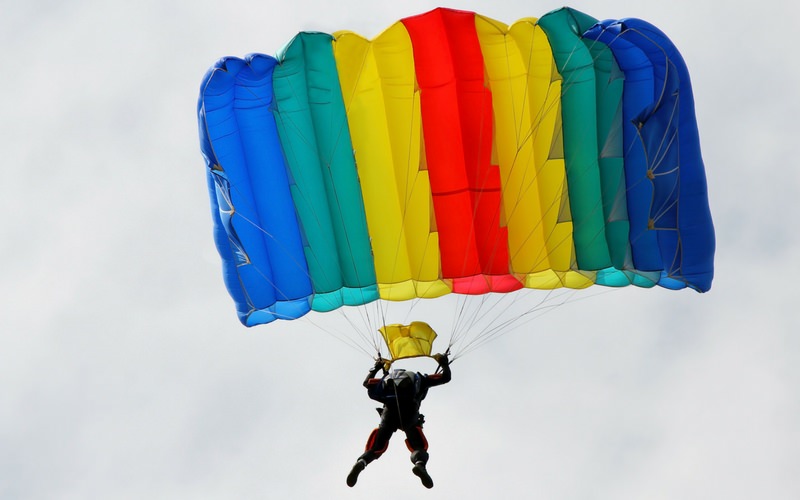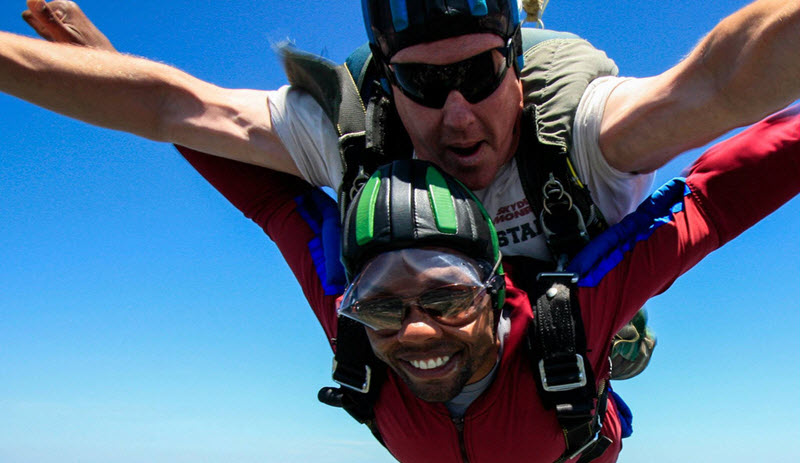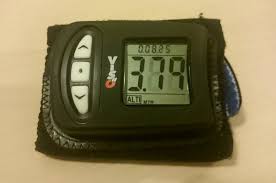Every sport has a few pieces of essential equipment. What would baseball be without a bat or glove? How about volleyball without a net? Or tennis without a racket? Skydiving is no different. Understandably, skydiving isn’t as mainstream, so you may not know much about essential skydiving equipment. Curious about the main pieces of skydiving gear every jumper holds dear? We are happy to break it down for you.
Main Parachute
Well, this may seem like a no-brainer, but the parachute is by far the most essential part of skydiving equipment! When asked to envision a parachute, most will picture an inflated dome-shaped fabric hovering above the suspended skydiver. Though, not exactly wrong, this is not the same skydiving gear that is used for civilian, recreational skydiving today.
Skydiving parachutes are incredibly diverse and come in a variety of sizes. The parachute used for tandem skydiving has a surface area of around 350 square feet. On occasion, and depending upon the size of the instructor and tandem student, an even larger parachute may be used. Student skydivers learning to skydive are also provided with a parachute. The size of parachutes generally used for student skydivers will vary from about 220 to 260 square feet.
All skydiving parachutes are contained within a sturdy fabric “backpack”, which we refer to as a skydiving container or a “rig”. Many licensed skydivers choose to personalize their rigs with specific colors and even embroidery. Though, above all, skydivers seek to have this piece of skydiving equipment fit them snugly and comfortably.

Reserve Parachute
Another very important part of skydiving equipment is the reserve parachute. In the unlikely event there is an issue with the main parachute, the reserve parachute serves as a backup.
Way back in the day, the reserve parachute was carried separately and attached to the jumper’s belly. While this did the job for a time, it simply wasn’t an ideal (or safe) configuration for reserve parachute storage.
Today we utilize a dual canopy container system. Both parachutes, the reserve and the main parachute, are contained within the skydiving rig. The main parachute sits toward the bottom of the backpack, and the reserve parachute sits in a separate tray located between the jumper’s shoulder blades.
Skydiving Helmet
Skydiving helmets come in many shapes, sizes, and even customizable colors. Skydiving helmets can certainly make a fashionable impression. More importantly, though, they are necessary for protecting our precious craniums! This is why the skydiving helmet makes it onto our essential skydiving equipment list.
Around the dropzone, you will see student skydivers and instructors alike sporting hard plastic-shelled skydiving helmets. Skydiving helmets help protect our beautiful noodles within the aircraft and in the event we are whacked or smacked by a rogue appendage in freefall. A knee to the noggin is never much fun, even less so if you’re moving at 120 mph or more.
We provide our tandem students with a soft, leather helmet to protect them from abrasions as they enter and exit the aircraft. The leather helmet also provides protection in the event a piece of debris is kicked upon landing. As an added benefit, the helmet can also help keep wily locks controlled and prevent one massive knotted mess. If you think a stiff breeze can mess up your hairdo, just imagine the tangles from a 120 mph freefall!

Goggles
Skydiving goggles are a simple but essential piece of skydiving equipment. For those who do not wear a full-face skydiving helmet, a pair of skydiving goggles is downright necessary. Goggles are used to protect your eyes during freefall. We wouldn’t want you to miss a second of this adventure, so we even have goggles that are specially made to be worn by individuals who require corrective lenses.
Skydiving goggles can be tinted, colored, or clear to fit the preference of the wearer. Tandem students and student skydivers are provided with clear goggles to ensure there is no interference with their vision.
Altimeter
Skydiving requires a keen awareness of altitude. This is where this particularly handy piece of skydiving equipment comes in. An altimeter reads barometric pressure to determine the jumper’s altitude at all times. Altimeters can be either analog or digital. The analog altimeter looks a bit like a watch face with a single hand. As the altitude changes, the hand “ticks” around the altimeter to indicate the altitude of the wearer. Digital altimeters display the altitude of the wearer in a digital format. Both work equally well and are selected solely on preference.

Skydiving Gear Just For You
At Skydive Monroe, we make sure you have all the skydiving gear you need. Whether it is your first tandem skydive or you have decided you want to learn to skydive for yourself, we have your skydiving gear covered.
Ready to get geared up? Contact or visit us at Skydive Monroe today!
Copyright © 2024, Skydive Monroe, All Rights Reserved.
DropZone Web Design & Marketing by Beyond Marketing, LLC



